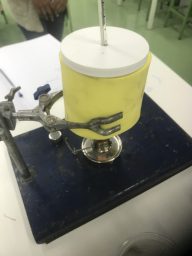Eggshell Calcium Carbonate Analysis Experiment Instruction Sheet
Introduction: Eggshells are made mainly of calcium carbonate, which is an important component in many industries. In Eggshell Calcium Carbonate Analysis Experiment , you will determine the percentage of calcium carbonate present in an eggshell using a technique called acid-base titration.
Materials:
- Eggshells
- 2 M HCl solution
- Burette
- Pipette
- Indicator solution (e.g. phenolphthalein)
- Beaker or flask
- Stirring rod
Procedure:
- Obtain a clean, dry burette and fill it with 2 M HCl solution. Record the initial burette reading.
- Obtain a clean, dry 250-mL beaker or flask and add approximately 50 mL of distilled water to it.
- Crush and grind the eggshells into a fine powder and add it to the beaker or flask with distilled water.
- Add a few drops of indicator solution (e.g. phenolphthalein) to the mixture and stir.
- Slowly add the HCl solution from the burette to the mixture while stirring, until the solution changes color (indicating the endpoint of the titration). Record the final burette reading.
- Repeat the titration at least 2 more times and calculate the average volume of HCl solution used.
- Use the balanced equation for the acid-base reaction (CaCO3 + 2HCl -> CaCl2 + H2O + CO2) and the volume and concentration of the HCl solution to determine the percentage of calcium carbonate present in the eggshell.
Precautions:
- Be sure to wear gloves and goggles during the experiment.
- Be sure to use clean, dry equipment and solutions.
- Do not ingest any of the solutions used in the experiment.
- Take care when handling the burette and pipette as they contain chemicals that can cause injury if spilled or broken.
- Be aware that eggshells may contain other impurities that could interfere with the results of the titration.
Practice questions
Q1. Determine the number of ml of 2 M HCl solution used in the titration when the initial burette reading is 25.0 mL and the final burette reading is 40.5 ml.
Q2. Calculate the number of moles of CaCO3 present in the eggshell using the balanced equation for the acid-base reaction (CaCO3 + 2HCl -> CaCl2 + H2O + CO2), the volume of HCl solution used in the titration (35.0 ml) and its concentration (2 M)
You should also go through the IB DP chemistry IA section here

